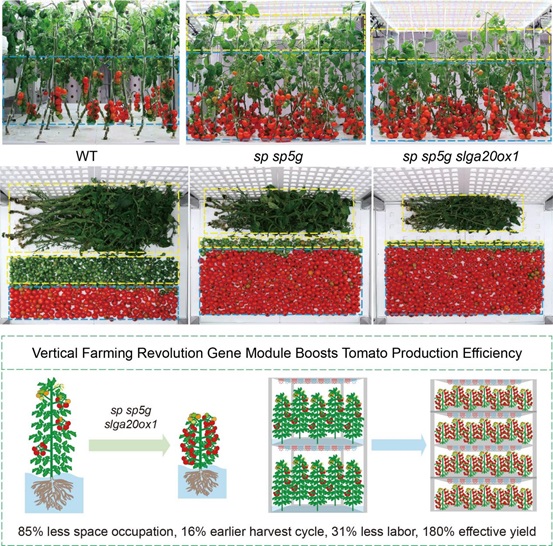A research team led by Prof. XU Cao from the Institute of Genetics and Developmental Biology (IGDB) of the Chinese Academy of Sciences, in collaboration with Prof. CHEN Fan's team at Yazhouwan National Laboratory, has successfully engineered a tomato variety optimized for vertical farming, significantly enhancing production efficiency in plant factory systems.
Their findings, published on May 12 in the Journal of Integrative Plant Biology, demonstrate how the integration of Green Revolution gene homologs with anti-florigen genes via genome editing can address longstanding barriers to scaling vertical agriculture.
Vertical farming, also known as plant factory systems, combines controlled-environment agriculture with vertical cultivation methods to enable high-yield, industrial-scale crop production. However, this model faces significant challenges including excessive energy demands and limited availability of crop varieties optimized for indoor cultivation, which impeded the industrial-scale expansion of plant factory systems. This model is increasingly viewed as a promising solution to the challenges posed by climate change, diminishing arable land, water scarcity, and rapid urbanization. By buffering against climatic variability, supporting decentralized food production, and offering modular deployment for emergency response, vertical farming holds strategic potential for food security in the 21st century.
Despite its promise, the large-scale deployment of vertical farming has been hindered by two major obstacles: high energy consumption and a lack of crop varieties suited to indoor, space-efficient cultivation. Most traditional crops—particularly fruiting solanaceous vegetables such as tomato, cucumber, and pepper—have complex growth patterns and extended harvest cycles, making them poorly adapted to confined, high-density farming environments. As a result, vertical farms have predominantly focused on growing fast-cycling, compact leafy greens.
To address this, Prof. XU Cao's team aggregated the Green Revolution gene homologs GA20ox with anti-florigen genes SP and SP5G, successfully creating a molecular module designed to revolutionize vertical farming. Knocking out the tomato SlGA20ox1 gene leads to a promising plant architecture suitable for vertical farming, characterized by short stems and a compact canopy. When cultivated in a commercial vertical farm equipped with a multi-layer LED automated hydroponic growth system, the slga20ox1 mutant saved the space occupation by 75%, achieving a 38%-69% fruit yield increase with high-density planting, efficient space utilization, and low lighting energy consumption.
By combining mutations of the SlGA20ox1 gene with the SP and SP5G genes, they have created a more compact plant architecture with accelerated flowering and synchronized fruit ripening.
In commercial vertical farms, the sp sp5g slga20ox1 mutant reduced space occupancy by 85%, shortened the harvest cycle by 16%, and increased effective yield by 180%, significantly enhancing production efficiency.
Since the gibberellin and florigen pathways are conserved cross various crops, the molecular module developed in our study to revolutionize vertical farming is promising to be applicable for the rapid customization of specialized varieties in other solanaceous vegetable for vertical farming.
Overall, this study provides a new solution for rapidly develop fruit and vegetable cultivars tailored for vertical farming.
Genome editing of molecular module for "vertical farming revolution" significantly enhance tomato production efficiency (Image by IGDB)





